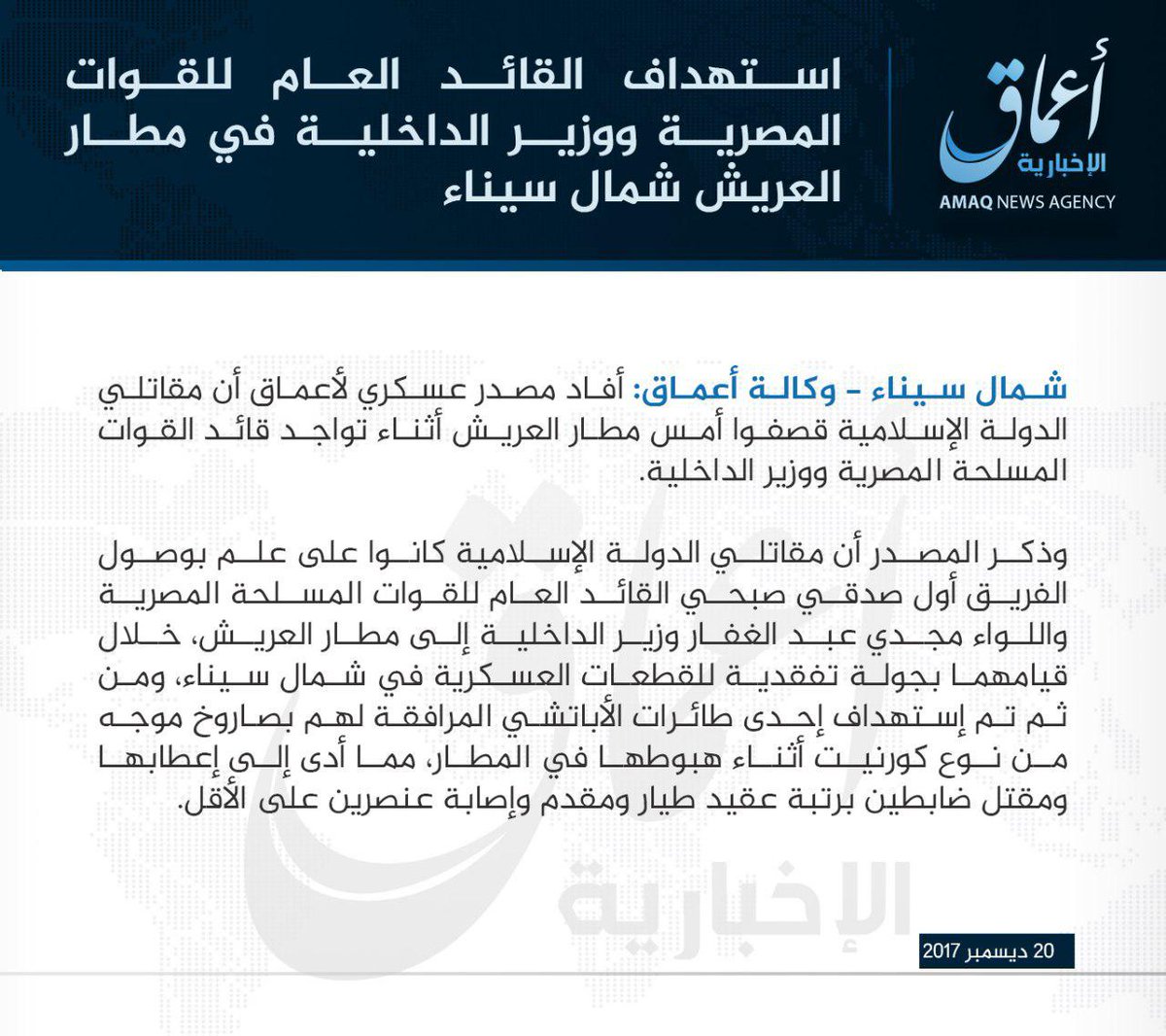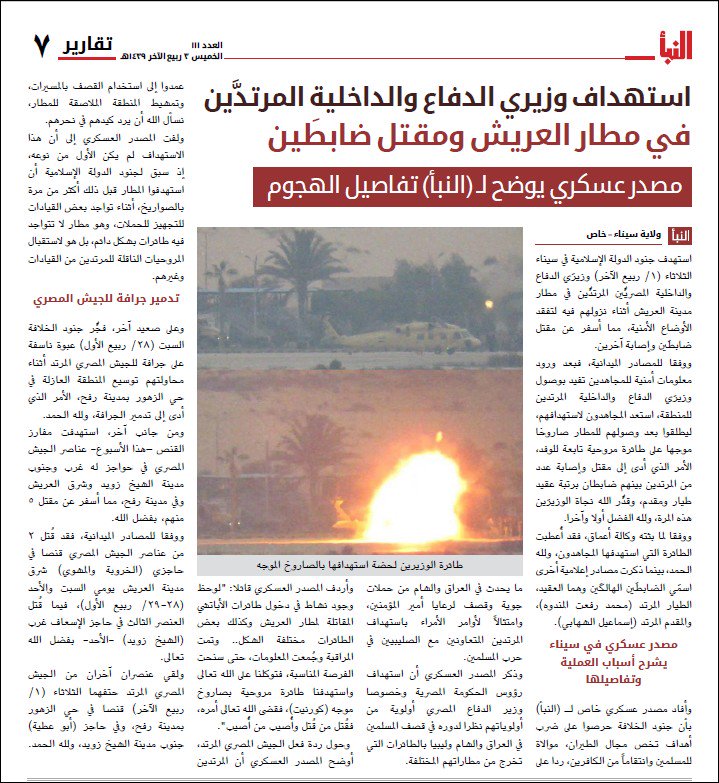Case study: December 20 attack on al-Arish Airport
On December 20, an anti-tank guided missile (ATGM) targeted a helicopter on the ramp of al-Arish Airport, located in Egypt’s North Sinai Governorate. The helicopter carried, among others, the Egyptian interior and defense ministers who disembarked from the aircraft shortly before the attack.
On December 21, the Islamic State (IS)-linked news agency released a report on the attack, alongside a claim of responsibility by the local IS affiliate Wilayat Sinai, stating that the group had prior knowledge of the arrival of the ministers and dispatched a team of militants to ambush the entourage. It further stated that the attack was conducted with the use of a 9M133 “Kornet” ATGM that targeted an AH-64 Apache attack helicopter that was escorting the VIPs.

Later that day, the IS-linked news agency released a video showing the attack itself, in which the ministers and their entourage can be seen next to the helicopter with its navigation lights still on, which contrary to initial publications was a UH-60 “Blackhawk”, as it was hit by an ATGM.
Edition number 111 of IS’s weekly al-Naba newsletter published on December 22 included a more detailed and contradictory account of the attack, stating that militants spotted a helicopter with a “unique shape” and concluded that this would be a high value target.
This prompted militants to dispatch an ATGM team to a position overlooking the airport with the objective of destroying the “unique aircraft”.
It is important to mention that the Egyptian Air Force (EAAF) reportedly operated two Blackhawk helicopters prior to the attack, mainly in the role of VIP transport. These aircraft are much more distinct than others that would commonly be seen in Sinai’s airspace, such as Apaches or Mi-17s.

Analysis of the missile launch:
While there has been no corroboration as to the type of missile used by IS in the attack at the time of writing, Wilayat Sinai have employed Kornets several times in the past, most notably in July 2015 when the group used the missile to attack an Egyptian naval vessel off the coast of North Sinai’s Rafah.
If the missile used was in fact a Kornet as IS claims, given that the missile was in flight for 14 seconds from launch until it hit its target and given that the speed of a standard Kornet missile is between 250 and 300 meters a second, it would place the launcher between 3.5 and 4.2 km from the target, well within the Kornet’s effective daytime range.
By comparing the video and imagery analysis of Al-Arish Airport, we concluded that the missile was launched from an elevated structure or a dirt berm southwest of the helicopter’s position, as can be see in the following map:
Threat posed to aviation from proliferation of ATGMs
The attack does not represent a precedent, but rather serves as an opportunity to highlight the threat posed to aviation from the proliferation of ATGMs in the hands of numerous militant groups in multiple countries. Several accounts of ATGMs being fired against aircraft were recorded in recent years, including successfully targeting aircraft in flight, with the most prominent example being the downing of an Israeli Air Force (IAF) helicopter by Hezbollah in Lebanon on August 12, 2006. This is especially important as this threat is often overlooked in comparison to the more well known threat posed by man-portable air defense systems (MANPADS).
While MANPADS pose a more prominent threat to aircraft, as they were designed with the specific goal of targeting aircraft, they have several shortcomings compared to ATGMs. These mainly include being more delicate, having parts with short shelf lives, requiring greater expertise and training to successfully operate, and being more rare. ATGMs still require expertise and training, although less than MANPADS, and are generally more durable and can be sustained for operations over longer time and in harsher conditions. Most importantly however, ATGMs are significantly more common than MANPADS, and with the destabilization of countries such as Libya, Syria, Iraq, and Yemen, thousands of these systems, of different generations and capabilities, were taken away from military storage and ended in the hands of militant groups across the world. This is in addition to illegal purchases through stable countries that do not adhere to international norms, such as Belarus and North Korea.
As noted, ATGMs were not designed primarily to hit aircraft and therefore do not excel in it, however, the features for which they were designed, namely attacking a comparatively slow moving target, still make them effective weapons against aircraft. This is mostly relevant during the takeoff and landing stages of both rotary and fixed-wing aircraft, when these are most vulnerable due to their low speed and altitude. In addition, while there are several options of countermeasures against MANPADS that can be used by civil aircraft, countermeasures against ATGMs are fewer, and often involve explosives, making them currently non-optional for civil aircraft.
An additional weakness exposed in the recent attack is the dependency on local security forces and their protocols, which can often be low in standard. The attack occurred in a region currently undergoing prolonged and high intensity militant activity, in a city that was hit by the most attacks in the region in recent months. Despite this fact, the VIPs were flown in a distinct helicopter that draws attention, the airport lacks even basic and cheap means in place that may disrupt or prevent a missile attack, such as walls that would block line of sight into the airport, or metal nets that would negate the missile’s shaped charge mechanism. All of these expose the weaknesses of local security protocols, which were a direct factor in the attack.
Recommendations
The threat of ATGMs should be considered as a potential factor while conducting risk and vulnerability surveys, particularly in unstable regions.
Prior to conducting aerial activity in countries with known militant activity, contact us at [email protected] to consult on the possible threat posed by relevant militant groups’ weapons and capabilities and ways to mitigate these.
Contact us at [email protected] or +44 20-3540-0434 for security surveys of airports.
